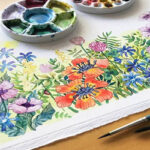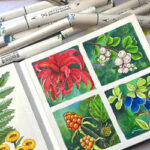A Simple Guide to Photographing Your Paintings by Jeanne Bessette
Because of my previous life as a photographer, I am often asked how to photograph your paintings. I can’t stress enough how important good images of your work is. You spend endless hours creating beautiful paintings and if you follow a few simple steps, it will make all the difference in your presentation to the world. You will get into more shows and you will look like a professional.
But first I want to make a small list of things not to do.
1. Do not take pictures of your work lying down on the floor with your feet in the bottom of the image.
2. Do not ask your spouse to hold the painting for you so he or she can also be in the picture.
3. Do not frame the image so it will look nice in the picture.
4. Mostly, do not put the camera on a timer and step into the picture to create a self portrait unless of course you need an image of yourself.
These may sound like silly examples of what not to do but believe me they happen.
There are several reasons we need photographs of our work and each situation warrants a different approach. For today, I am going to address low resolution images for your website and email applications. This of course starts with a relatively good quality digital camera. You can use any point and shoot for this as long as it has at least 4 mega pixels. I find the lower quality cameras just don’t cut the mustard. You will also need a computer and a way to upload your images. I use Picassa because it is quick and pretty idiot proof.
A good quality, sturdy tripod is a must. Do not underestimate the need for a tripod. It keeps your camera steady and allows you to perfectly align the painting in the viewfinder, which is essential.
Most digital cameras have more than one setting for resolution. I like to shoot my paintings in the higher resolution (1600X1200 or more) in case I decide to use an online postcard company or send my image off for advertising. You can always lower the resolution on the computer for your website and emails.
Now that you are more familiar with what you need, here are the steps that I use for actually photographing the image.
1. I shoot all my paintings outside on a sunny day. I shoot either midmorning or mid afternoon and put the sun at a 45 degree angle behind me. So in photographer’s terms, I have a giant light box of warm light spilling onto my subject. If it is a cloudy day, you will get a blue cast on your painting and good luck getting the blue out later.
2. I have created a black velvet back drop. I have glued the black velvet to a large piece of plywood. (Black velvet is pure black and absorbs light.) And I hang my painting on a nail. Ultimately, I crop to the exact edges of the painting once I upload it. But if I have a square painting and I do not want to crop to the edges, the black background will fall away to the viewer and the painting will “pop.”
3. I set up my camera on the tripod and make sure that the camera is exactly perpendicular to the painting and the height is exactly in the middle of the painting’s height. Double check all edges to make sure you are square and fill the view finder as much as possible with the painting. Check for hot spots or glare from the sun and adjust the painting if necessary. It is better to photograph your paintings before the final coat of varnish to help with glare, but I have photographed all my paintings after varnish with success and adjustments.
4. Set your camera on point and shoot or if you feel savvy, set it on fstop 60. Shoot more than one image.
5. Upload your images to your computer. Keep good files of your work and don’t forget to create backups often.
These simple steps will help elevate your photographs to a place that you can feel confident in shooting your own images.
If you have any questions, feel free to email me at [email protected].
See you in the studio!!!





